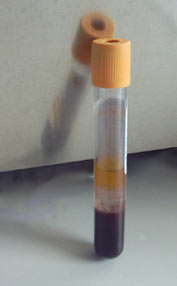
Blood fractionation
Encyclopedia


Fractionation
See also: Fractionated spacecraftFractionation is a separation process in which a certain quantity of a mixture is divided up in a number of smaller quantities in which the composition changes according to a gradient. Fractions are collected based on differences in a specific property of the...
whole blood
Whole blood
Whole blood is a term used in transfusion medicine for human blood from a standard blood donation. The blood is typically combined with an anticoagulant during the collection process, but is generally otherwise unprocessed...
, or separating it into its component parts. This is typically done by centrifuging
Centrifuge
A centrifuge is a piece of equipment, generally driven by an electric motor , that puts an object in rotation around a fixed axis, applying a force perpendicular to the axis...
the blood
Blood
Blood is a specialized bodily fluid in animals that delivers necessary substances such as nutrients and oxygen to the cells and transports metabolic waste products away from those same cells....
.
The resulting components are:
- a clear solutionSolutionIn chemistry, a solution is a homogeneous mixture composed of only one phase. In such a mixture, a solute is dissolved in another substance, known as a solvent. The solvent does the dissolving.- Types of solutions :...
of blood plasmaBlood plasmaBlood plasma is the straw-colored liquid component of blood in which the blood cells in whole blood are normally suspended. It makes up about 55% of the total blood volume. It is the intravascular fluid part of extracellular fluid...
in the upper phase (which can be separated into its own fractions, see Blood plasma fractionationBlood plasma fractionationBlood plasma fractionation refers to the general processes of separating the various components of blood plasma, which in turn is a component of blood obtained through blood fractionation.-Blood plasma:...
), - the buffy coatBuffy coatThe buffy coat is the fraction of an anticoagulated blood sample after density gradient centrifugation that contains most of the white blood cells and platelets.-Description:...
, which is a thin layer of leukocytes (white blood cells) mixed with plateletPlateletPlatelets, or thrombocytes , are small,irregularly shaped clear cell fragments , 2–3 µm in diameter, which are derived from fragmentation of precursor megakaryocytes. The average lifespan of a platelet is normally just 5 to 9 days...
s in the middle, and - erythrocytes (red blood cells) at the bottom of the centrifuge tube.
Serum separation tubes
Serum-separating tube
Serum-separating tubes, also known as serum separator tubes or SSTs, are used in medical clinical chemistry tests requiring blood serum.SSTs are sometimes called "marble-top tubes" or "yellow topped tubes", referring to the stoppers which are either gold or red-gray...
(SSTs) are tubes used in phlebotomy
Venipuncture
In medicine, venepuncture, venopuncture or venipuncture is the process of obtaining intravenous access for the purpose of intravenous therapy or for blood sampling of venous blood. This procedure is performed by medical laboratory scientists, medical practitioners, some EMTs, paramedics,...
containing a silicone gel; when centrifuged the silicone gel forms a layer on top of the buffy coat, allowing the blood plasma to be removed more effectively for testing and related purposes.

